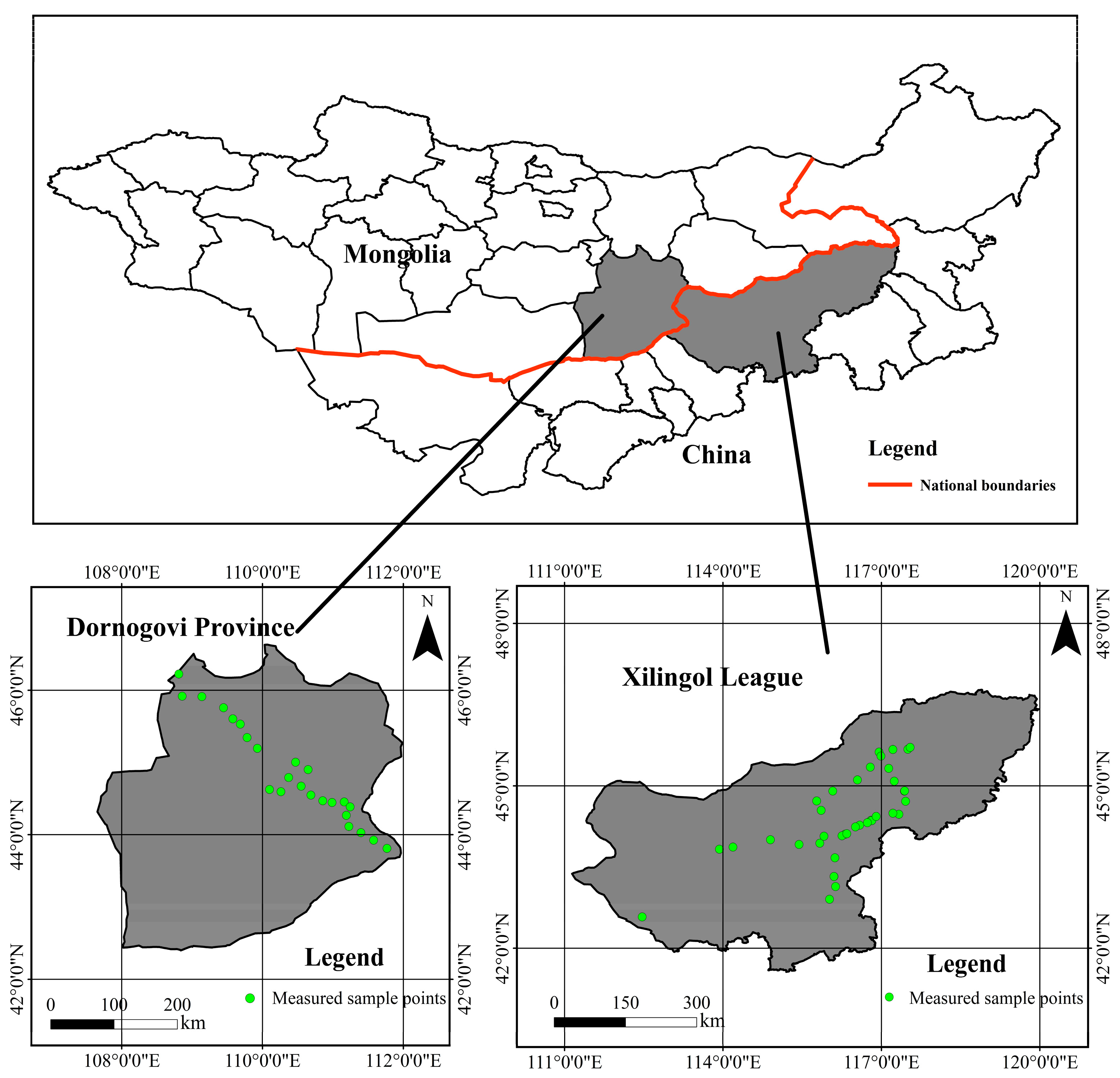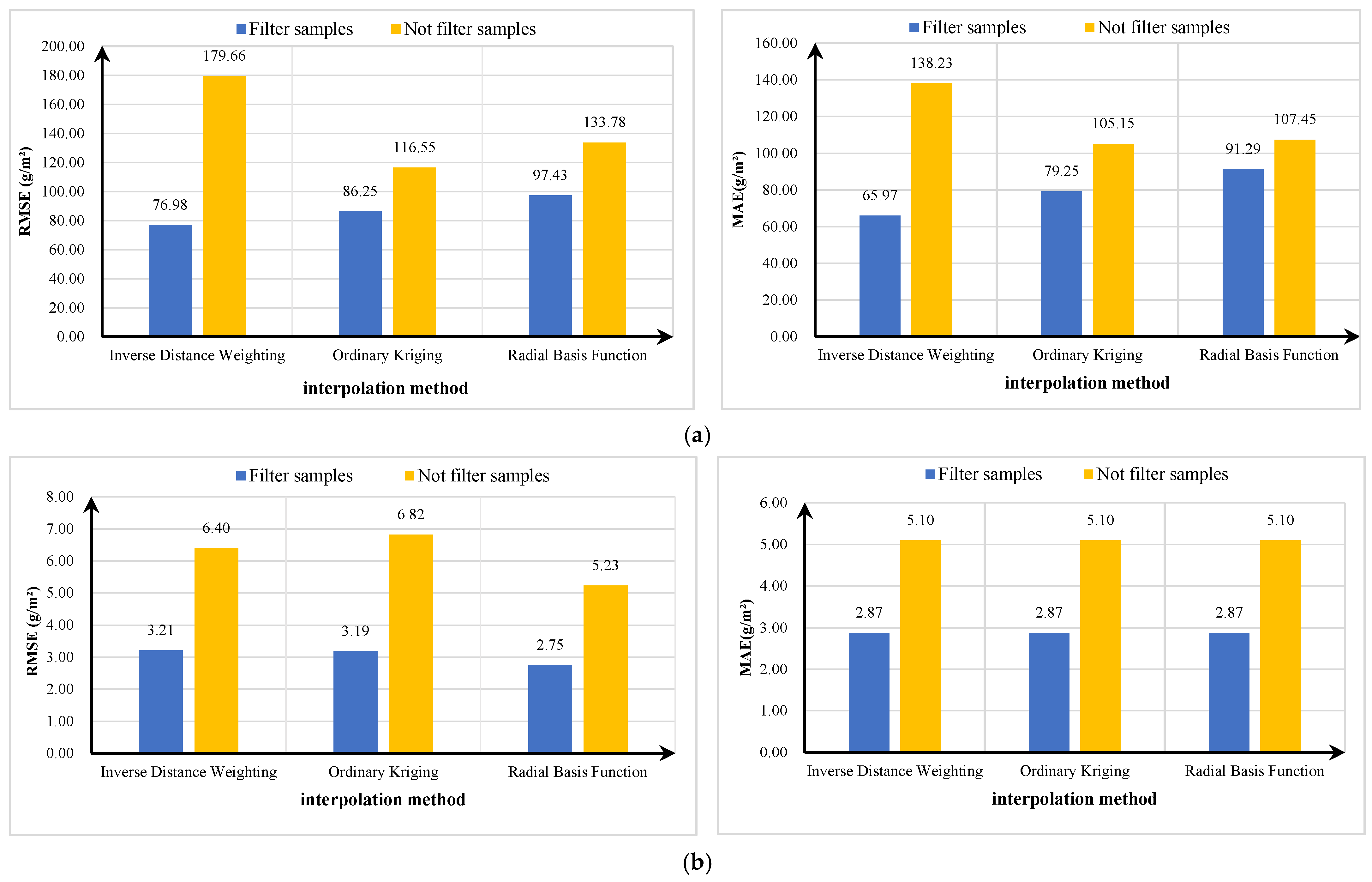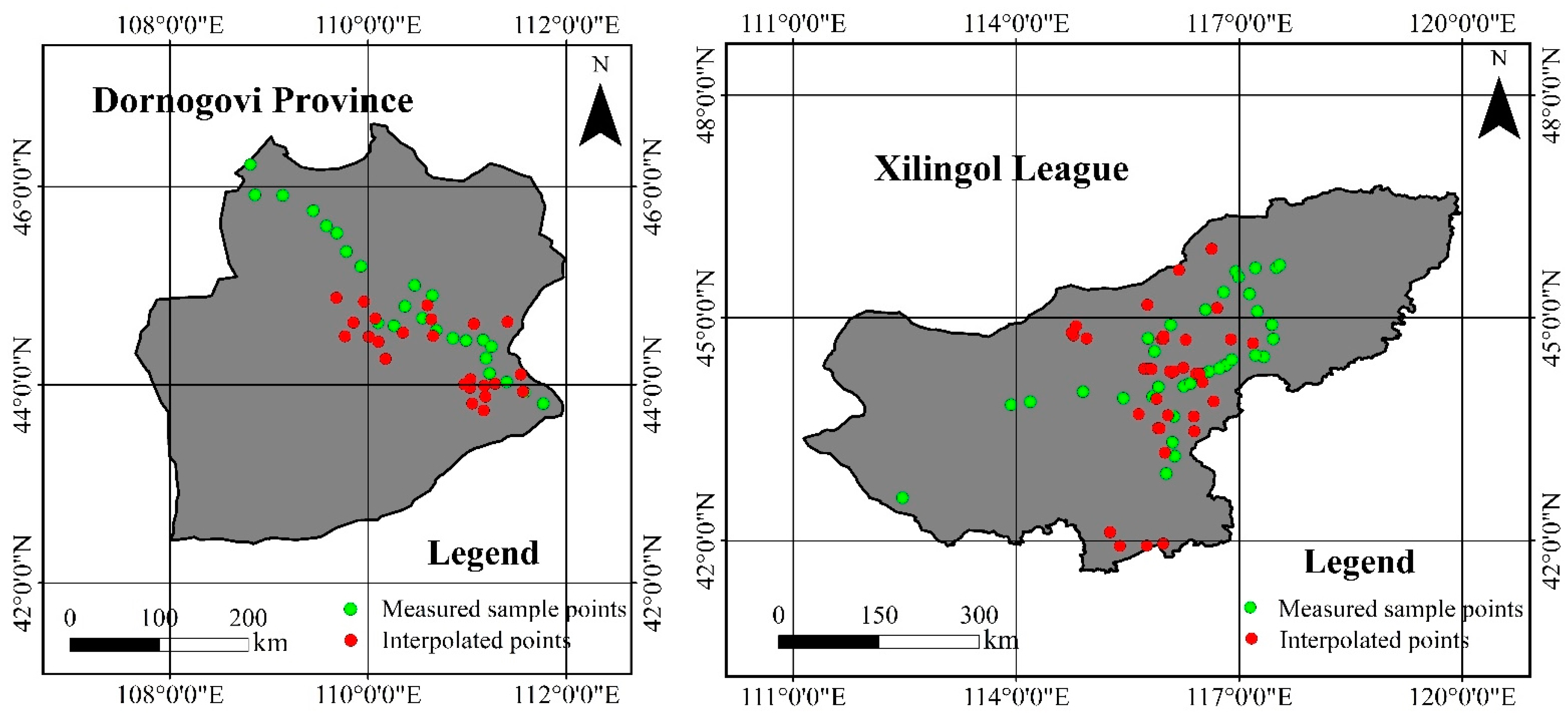Applicability of Grassland Production Estimation Using Remote Sensing for the Mongolian Plateau by Comparing Typical Regions in China and Mongolia
Abstract
:1. Introduction
2. Materials and Method
2.1. Study Area Overview
2.2. Data Source
2.2.1. Remote Sensing Data
2.2.2. Measured Sample Points for Grassland Production
2.3. Interpolation Method
2.3.1. Objective
2.3.2. Sample Point Ratio
2.3.3. Estimation Weighting
3. Results
3.1. Interpolation Accuracy
3.2. Results of the Interpolated Sample Points
3.3. Grassland Production Estimation Model
3.3.1. Model Building
3.3.2. Model Validation
3.3.3. Estimation Results
4. Discussion
4.1. Applicability of Sample Interpolation Method
4.2. Grassland Production Temporal-Spatial Distribution and Driving Forces
5. Conclusions
Author Contributions
Funding
Institutional Review Board Statement
Informed Consent Statement
Data Availability Statement
Conflicts of Interest
References
- Zhang, Y.Z.; Wang, Z.Q.; Yang, Y.; Li, J.L.; Zhang, Y.; Zhang, C.B. Research on the Quantitative Evaluation of Grassland Degradation and Spatial and Temporal Distribution on the Mongolia Plateau. Pratacult. Sci. 2018, 35, 233–243. [Google Scholar]
- Dai, L.; Zhang, L.; Wang, K.; Wang, R.L. Vegetation Changing Trend and Its Affecting Factors in Mongolian Plateau. Bull. Soil Water Conserv. 2014, 34, 218–225. [Google Scholar]
- Huang, X.; Liu, J.H.; Shen, K.J.; Liu, Y.M.; Wang, L. Grassland Yield Change in Qinghai Province Based on MODIS Data, ARID LAND. Geography 2020, 43, 715–725. [Google Scholar]
- Xu, B.; Yang, X.; Tao, W.; Qin, Z.; Liu, H.; Miao, J. Remote Sensing Monitoring Upon the Grass Production in China. Acta Ecol. Sin. 2007, 27, 405–413. [Google Scholar] [CrossRef]
- Wang, S.L.; Wang, R.X.; Jing, W.M.; Zhao, W.J.; Niu, Y.; Zhu, H. Biomass of Grassland and Response to Soil Moisture on Arid Mountain Land in the Qilian Mountains. Arid Land Geogr. 2017, 40, 772–779. [Google Scholar] [CrossRef]
- Wang, Q.; Wu, C.; Cheng, K.; Zhang, X.; Zhang, L.; Ding, J. Estimating Grassland Yield and Carrying Capacity in Qinghai Lake Basin Based on MODIS NPP Data. Ecol. Sci. 2019, 38, 178–185. [Google Scholar]
- Dong, R.L.; Jia, W.; Yu, G.H. Research Progress on Prediction Models of Grass Yield and Livestock Carrying Capacity of Grassland. Acta Agrestia Sin. 2018, 26, 1043–1051. [Google Scholar]
- Li, P.; Zang, Y.; Chan, F.K.S.; Wang, J. Desertification and Its Control Along the Route of China’s “Belt and Road Initiative”: A Critical Review. Authorea 2020. [Google Scholar] [CrossRef]
- Yi, G.; Zhang, T.; He, Y.; Ye, H.; Li, J.; Bie, X.; Liu, D. Applicability Analysis of Four Spatial Interpolation Methods for Air Temperature. J. Chengdu Univ. Technol. 2020, 47, 115–128. [Google Scholar]
- Wang, S.; Liu, Y.; Zhu, C.; Jiang, H. Contrast on Different Spatial Interpolation Methods of Daily Surface Temperature Data in Terrain Complex Area, Qinghai Province. Plateau Meteorol. 2011, 30, 1640–1646. [Google Scholar]
- Jiang, X.J.; Liu, X.J.; Huang, F.; Jiang, H.Y.; Cao, W.X.; Zhu, Y. Comparison of Spatial Interpolation Methods for Daily Meteorological Elements. Yingyong Shengtai Xuebao 2010, 21, 624–630. [Google Scholar] [PubMed]
- You, S.C.; Li, J. Study on Error and Its Pervasion of Temperature Estimation. J. Nat. Resour. 2005, 1, 140–144. [Google Scholar]
- Li, P.F.; Li, M. Study on Vegetation Fraction Based on Kriging Interpolation Method—A Case Study of Zhaling Lake, Eling Lake. J. Anhui Agric. Sci. 2015, 43, 321–324. [Google Scholar]
- Qiao, Y.X.; Zhu, H.Z.; Shao, X.M.; Zhong, H.P.; Zhou, L.L.; Wu, Z.W. Automatic Classification of Grassland Type in Xinjiang Ili Based on Spatial Interpolation of Remote Sensing and Other Data. Acta Pratacult. Sin. 2017, 26, 30–45. [Google Scholar]
- Wang, J.F.; Reis, B.Y.; Hu, M.G.; Christakos, G.; Yang, W.Z.; Sun, Q.; Li, Z.J.; Li, X.Z.; Lai, S.J.; Chen, H.Y.; et al. Area Disease Estimation Based on Sentinel Hospital Records. PLoS ONE 2011, 6, e23428. [Google Scholar] [CrossRef] [Green Version]
- Wang, J.F.; Hu, M.G.; Xu, C.D.; Christakos, G.; Zhao, Y. Estimation of Citywide Air Pollution in Beijing. PLoS ONE 2013, 8, e53400. [Google Scholar] [CrossRef] [Green Version]
- Karimian, H.; Li, Q.; Li, C.C.; Fan, J.; Jin, L.; Gong, C.; Mo, Y.; Hou, J.; Ahmad, A. Daily Estimation of Fine Particulate Matter Mass Concentration through Satellite Based Aerosol Optical Depth. ISPRS Ann. Photogramm. Remote Sens. Spatial Inf. Sci. 2017, W2, 175–181. [Google Scholar] [CrossRef] [Green Version]
- Wang, Y.J.; WANG, J.L.; Wei, H.S.; Ochir, A.; Davaasuren, D.; Chonokhuu, S. Study on Estimation Method of Mongolia Grassland Production Based on Sparse Samples. J. Geo-Inf. Sci. 2020, 22, 1814–1822. [Google Scholar]
- Mongolian Statistical Information Service. Available online: www.1212.mn (accessed on 22 January 2022).
- Wang, J.; Liao, Y.; Liu, X. Spatial Data Analysis Tutorial; Science Press: Beijing, China, 2010. [Google Scholar]
- Li, X.; Zhang, Y.; Yang, S.; Yuan, F.; Zhou, T. Comparison of Typical Interpolation Methods for Pollution Evaluation of Soil Heavy Metals in Yicheng District, Hefei. J. Jilin Univ. (Earth Sci. Ed.). 2011, 41, 222–227. [Google Scholar]
- Tang, G.B. Study on Data Refinement Method of Soil Heavy Metals in Agricultural Land; Xi’an University of Science and Technology: Xi’an, China, 2021. [Google Scholar]
- Tamir, P. Study on the Response of Grassland Vegetation on Climate Change in the Eastern Mongolian Plateau; Inner Mongolia Agricultural University: Hohhot, China, 2017. [Google Scholar]
- Chen, G.; Li, Q.; Peng, F.; Karamian, H.; Tang, B. Henan Ecological Security Evaluation Using Improved 3D Ecological Footprint Model Based on Emergy and Net Primary Productivity. Sustainability 2019, 11, 1353. [Google Scholar] [CrossRef] [Green Version]
- Zhang, W.H.; Jia, Z.B.; Zhuo, Y.L.; Jiang, X.Y. Space Dynamic Change of Pasture Amount and Influence Factors Analysis in Xilin Gol Grassland. Earth Environ. 2016, 7, 163–172. [Google Scholar]
- Lu, M.Y. The Study on Influencing Factors of Xilin Gol Grassland Degradation and Sustainable Use Countermeasure Research; Inner Mongolia Agricultural University: Hohhot, China, 2012. [Google Scholar]







| Interpolation Method | RMSE in Xilingol League (g/m2) | MAE in Xilingol League (g/m2) | RMSE in Dornogovi Province (g/m2) | MAE in Dornogovi Province (g/m2) |
|---|---|---|---|---|
| P-BSHADE | 47.32 | 43.10 | 4.66 | 3.87 |
| Inverse Distance Weighting | 76.98 | 65.97 | 3.21 | 2.87 |
| Ordinary Kriging | 86.25 | 79.25 | 3.19 | 2.87 |
| Radial Basis Function | 97.43 | 91.29 | 2.75 | 2.87 |
| Parameters | Model Type | Inversion Model | Sig. | R2 | RMSE (g/m2) | Accuracy (%) |
|---|---|---|---|---|---|---|
| NDVI | Linear model | y = 0.088x − 117.088 | 0.000 | 0.51 | 87.12 | 73.24% |
| Power function model | y = 0.000002 (x2.184) | 0.000 | 0.72 | 85.82 | 72.83% | |
| Exponential model | y = 26.968 × EXP (0.000441x) | 0.000 | 0.63 | 95.77 | 70.14% |
| Parameters | Model Type | Inversion Model | Sig. | R2 | RMSE (g/m2) | Accuracy (%) |
|---|---|---|---|---|---|---|
| NDVI | Linear model | y = 0.009x − 1.862 | 0.000 | 0.58 | 3.62 | 74.34% |
| Power function model | y = 0.004 (x1.079) | 0.000 | 0.63 | 3.55 | 74.83% | |
| Exponential model | y = 6.081 × EXP (0.00046x) | 0.000 | 0.61 | 3.78 | 73.22% |
Publisher’s Note: MDPI stays neutral with regard to jurisdictional claims in published maps and institutional affiliations. |
© 2022 by the authors. Licensee MDPI, Basel, Switzerland. This article is an open access article distributed under the terms and conditions of the Creative Commons Attribution (CC BY) license (https://creativecommons.org/licenses/by/4.0/).
Share and Cite
Li, Q.; Wang, J.; Xie, H.; Ochir, A.; Davaasuren, D. Applicability of Grassland Production Estimation Using Remote Sensing for the Mongolian Plateau by Comparing Typical Regions in China and Mongolia. Sustainability 2022, 14, 3122. https://doi.org/10.3390/su14053122
Li Q, Wang J, Xie H, Ochir A, Davaasuren D. Applicability of Grassland Production Estimation Using Remote Sensing for the Mongolian Plateau by Comparing Typical Regions in China and Mongolia. Sustainability. 2022; 14(5):3122. https://doi.org/10.3390/su14053122
Chicago/Turabian StyleLi, Qiong, Juanle Wang, Hongquan Xie, Altansukh Ochir, and Davaadorj Davaasuren. 2022. "Applicability of Grassland Production Estimation Using Remote Sensing for the Mongolian Plateau by Comparing Typical Regions in China and Mongolia" Sustainability 14, no. 5: 3122. https://doi.org/10.3390/su14053122
APA StyleLi, Q., Wang, J., Xie, H., Ochir, A., & Davaasuren, D. (2022). Applicability of Grassland Production Estimation Using Remote Sensing for the Mongolian Plateau by Comparing Typical Regions in China and Mongolia. Sustainability, 14(5), 3122. https://doi.org/10.3390/su14053122






